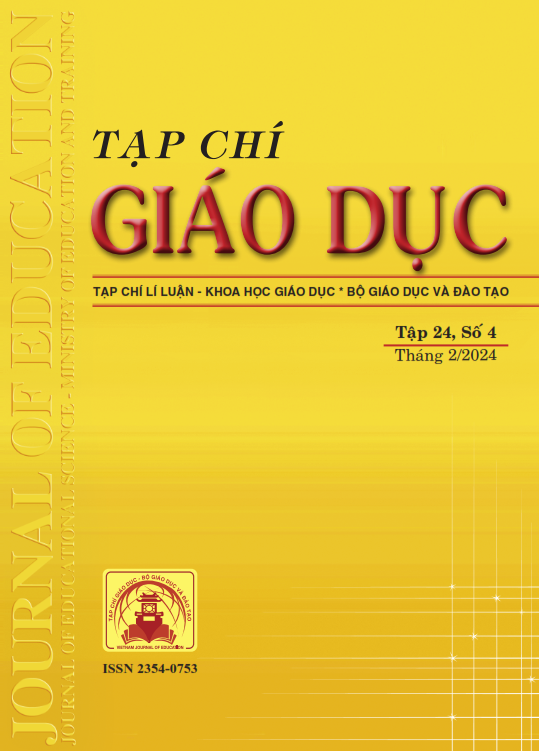Quy trình thiết kế và sử dụng video dạy học chủ đề “Nấm và vi khuẩn” môn Khoa học ở tiểu học
- Từ khóa:
- Materials
- Science subject
- fungi
- bacteria
- video
Tóm tắt
The topic of Fungi and Bacteria in the 2018 General Education Curriculum for Science Subject includes new content compared to the old one. The target subjects in this topic are mostly tiny in size and not visible to the naked eye. Therefore, the preparation of teaching materials to support teachers in organizing lessons for students is essential. This research study focuses on designing videos for teaching the topic of Fungi and Bacteria to fourth and fifth graders. Based on the proposed principles and designing process, the researcher has successfully designed three videos, including: “Bacteria around us”, “Are mushrooms our friends?” and “Why does yeast cause bread to rise?”. Experimental results of the two videos “Bacteria around us” and “Why does yeast swell bread?” imply that the designed materials are appropriate and effective in teaching, enhancing students' interest in discovering fungi and bacteria, creating opportunities for students to develop their competences to learn about fungi and bacteria and to apply learned knowledge and skills into practice.
Tài liệu tham khảo
Bộ GD-ĐT (2018). Chương trình giáo dục phổ thông - Chương trình môn Khoa học (ban hành kèm theo Thông tư số 32/2018/TT-BGDĐT ngày 26/12/2018 của Bộ trưởng Bộ GD-ĐT).
Bộ GD-ĐT (2021). Tài liệu hướng dẫn bồi dưỡng giáo viên phổ thông cốt cán “Môđun 9: Ứng dụng công nghệ thông tin, khai thác và sử dụng thiết bị công nghệ trong dạy học và giáo dục học sinh tiểu học môn Lịch sử và Địa lí”, tr 51-54.
Brown, C., & Green, T. D. (2018). The Process of Instructional Design. Routledge.
Bùi Uyên Phương, Nguyễn Minh Giang (2023). Thực trạng sử dụng học liệu dạy học chủ đề “Nấm và vi khuẩn” trong môn Khoa học của giáo viên tiểu học tại Quận 10, Thành phố Hồ Chí Minh. Tạp chí Thiết bị Giáo dục, 294(1), 19-20.
Carlson, R., Chandler, P., & Sweller, J. (2003). Learning and understanding science instructional material. Journal of Educational Psychology, 95(3), 629-640. https://doi.org/10.1037/0022-0663.95.3.629
Guo, P. J., Kim, J., & Rubin, R. (2014). How video production affects student engagement: An empirical study of MOOC videos. Proceedings of the First ACM Conference on Learning at Scale, 41-50. https://doi.org/10.1145/ 2556325.2566239
Joseph, O. C. (2015). Teaching Aids a Special Pedagogy Tool of Brain Development in School Children, Interest and Academic Achievement to Enhance Future Technology. Journal of Education and Practice, 6(29), 92-101.
Smaoui, A. (2021). The Development of a Language-and-Culture Course Incorporating Intercultural Teaching Materials in the Tunisian Higher Education EFL Context: Challenges and Opportunities. Open Journal of Modern Linguistics, 11(1). https://doi.org/10.4236/ojml.2021.111001
Trần Dương Quốc Hòa (2018). Xây dựng học liệu điện tử hỗ trợ dạy học tương tác ở tiểu học. Luận án tiến sĩ Khoa học giáo dục, Viện Khoa học Giáo dục Việt Nam.
Trịnh Lê Hồng Phương (2012). Xây dựng học liệu điển tử hỗ trợ việc dạy và học một số nội dung hóa học ở trường trung học phổ thông. Tạp chí Khoa học, Trường Đại học Sư phạm Thành phố Hồ Chí Minh, 37, 158-160.
Tải xuống
Đã Xuất bản
Cách trích dẫn
Số
Chuyên mục
Giấy phép

Tác phẩm này được cấp phép theo Ghi nhận tác giả của Creative Commons Giấy phép quốc tế 4.0 .












